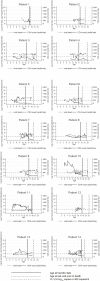Mortality and AIDS-defining events among young people following transition from paediatric to adult HIV care in the UK
- PMID: 33939876
- PMCID: PMC8612219
- DOI: 10.1111/hiv.13096
Mortality and AIDS-defining events among young people following transition from paediatric to adult HIV care in the UK
Abstract
Objectives: To investigate risk of AIDS and mortality after transition from paediatric to adult care in a UK cohort of young people with perinatally acquired HIV.
Methods: Records of people aged ≥ 13 years on 31 December 2015 in the UK paediatric HIV cohort (Collaborative HIV Paediatric Study) were linked to those of adults in the UK Collaborative HIV Cohort (CHIC) cohort. We calculated time from transition to a new AIDS event/death, with follow-up censored at the last visit or 31 December 2015, whichever was the earliest. Cumulative incidence of and risk factors for AIDS/mortality were assessed using Kaplan-Meier and Cox regression.
Results: At the final paediatric visit, the 474 participants [51% female, 80% black, 60% born outside the UK, median (interquartile range) age at antiretroviral therapy (ART) initiation = 9 (5-13) years] had a median age of 18 (17-19) years and CD4 count of 471 (280-663) cell/μL; 89% were prescribed ART and 60% overall had a viral load ≤ 400 copies/mL. Over median follow-up in adult care of 3 (2-6) years, 35 (8%) experienced a new AIDS event (n = 25) or death (n = 14) (incidence = 1.8/100 person-years). In multivariable analyses, lower CD4 count at the last paediatric visit [adjusted hazard ratio = 0.8 (95% confidence interval: 0.7-1.0)/100 cells/μL increment] and AIDS diagnosis in paediatric care [2.7 (1.4-5.5)] were associated with a new AIDS event/mortality in adult care.
Conclusions: Young people with perinatally acquired HIV transitioning to adult care with markers of disease progression in paediatric care experienced poorer outcomes in adult care. Increased investment in multidisciplinary specialized services is required to support this population at high risk of morbidity and mortality.
Keywords: AIDS; HIV; mortality; transition; young people.
© 2021 The Authors. HIV Medicine published by John Wiley & Sons Ltd on behalf of British HIV Association.
Figures
References
-
- Judd A, Doerholt K, Tookey PA et al. Morbidity, mortality, and response to treatment by children in the United Kingdom and Ireland with perinatally acquired HIV infection during 1996–2006: planning for teenage and adult care. Clin Infect Dis 2007; 45: 918–924. - PubMed
-
- Cohen S, Smit C, van Rossum AM et al. Long‐term response to combination antiretroviral therapy in HIV‐infected children in the Netherlands registered from 1996 to 2012. AIDS 2013; 27: 2567–2575. - PubMed
Publication types
MeSH terms
Substances
Grants and funding
LinkOut - more resources
Full Text Sources
Other Literature Sources
Medical
Research Materials



